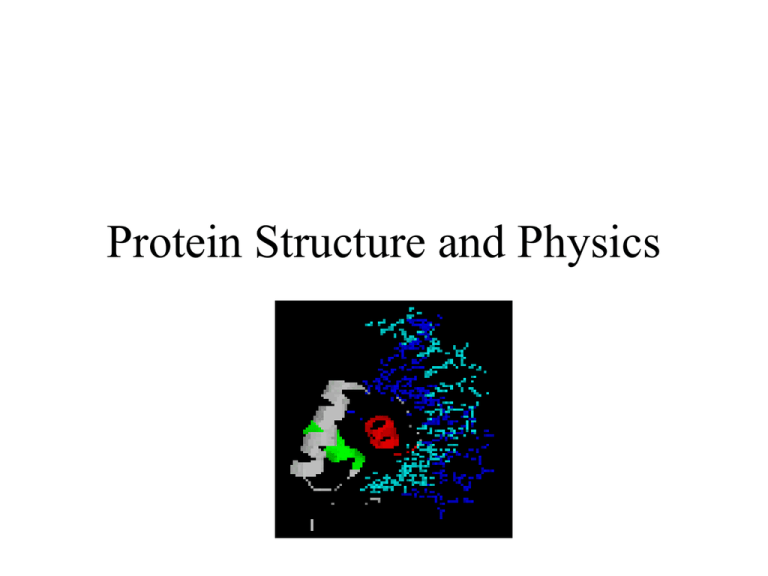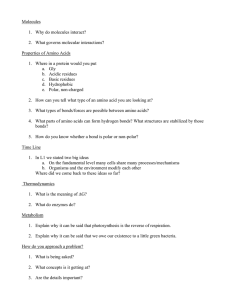DHaganTalk1.ppt
advertisement

Protein Structure and Physics What I will talk about today… -Outline protein synthesis and explain the basic steps involved. -Go over the Chemistry of a peptide bond -Define and exemplify a secondary structure of a protein. -Define a Protein motif and relate structure to function. -The protein folding “problem” and why it has become one of the most basic intellectual challenges in Molecular Biology. Protein Synthesis • Proteins are macromolecules (heteropolymers) made up from 20 different L-a-amino acids, also referred to as residues • Two amino acids are combined in a condensation reaction. • The sequence of the different amino acids is considered the primary structure of the peptide or protein. How is the primary structure of a protein determined in the first place? • DNA is transcribed into mRNA which is then translated into protein. • A codon is a sequence of 3 nucleotide bases that codes for 1 amino acid. • The “genetic code” tells us (based on the sequence of the mRNA) what the sequence of amino acids will be within the protein. Back to primary structure… • Now that we understand how the sequence of amino acids is determined here is how the amino acids are linked together. • A bond between two amino acids is called a peptide bond. Protein Secondary Structure • Once the primary structure has been established it is referred to as the “backbone” of the protein. • The secondary structure can be defined as the regular, repeated patters of folding of the protein backbone. The two most common folding patterns are the alpha helix and the beta sheet. • Patterns result from regular hydrogen bond patterns of backbone atoms. A Protein Motif • Secondary structure elements of a protein are connected together to form protein motifs. • An example of a protein motif is calmodulin. • The shape of the molecule allows calmodulin to recognize and bind calcium. • A similar motif is found in Parvalbumin (a muscle protein that also binds calcium). Physics and molecular biology • Proteins recognize thousands of molecules within the cell through 3D interactions. • Understanding biological functions of a protein requires knowledge of the structure. • The structure of the protein cannot be predicted by simply looking at the amino acid sequence. W.L. Bragg won the nobel prize in physics in 1915 for the first crystal structure analysis using x rays. To Review… • The amino acid sequence of a given protein is translated from mRNA and is inferred by the genetic code. • Each protein has its own specific primary, secondary and tertiary structure and the structure of the protein determines its function within the cell. • Present day biology relies enormously on tools that have been largely developed by physicists (protein crystallography experiments)




